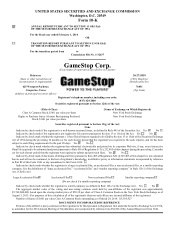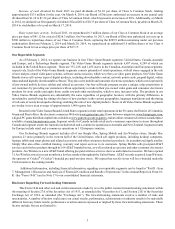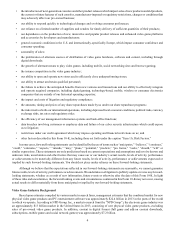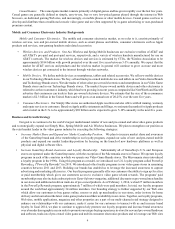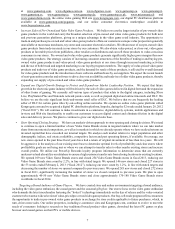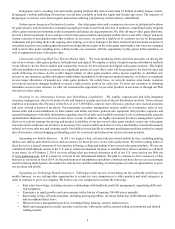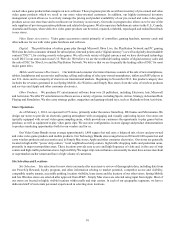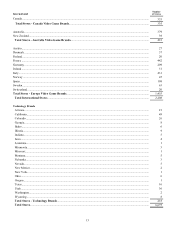GameStop 2013 Annual Report Download - page 21
Download and view the complete annual report
Please find page 21 of the 2013 GameStop annual report below. You can navigate through the pages in the report by either clicking on the pages listed below, or by using the keyword search tool below to find specific information within the annual report.4
• the introduction of next-generation consoles and other product releases which impact sales of new products and old products,
the current or future features of such consoles, manufacturer-imposed or regulatory restrictions, changes or conditions that
may adversely affect our pre-owned business;
• our ability to respond quickly to technological changes and evolving consumer preferences;
• our reliance on a limited number of suppliers and vendors for timely delivery of sufficient quantities of their products;
• our dependence on the production of new, innovative and popular product releases and enhanced video game platforms
and accessories by developers and manufacturers;
• general economic conditions in the U.S. and internationally, specifically Europe, which impact consumer confidence and
consumer spending;
• seasonality of sales;
• the proliferation of alternate sources of distribution of video game hardware, software and content, including through
digital downloads;
• the growth of alternate means to play video games, including mobile, social networking sites and browser gaming;
• the intense competition in the video game industry;
• our ability to open and operate new stores and to efficiently close underperforming stores;
• our ability to attract and retain qualified personnel;
• the failure to achieve the anticipated benefits from new ventures and transactions and our ability to effectively integrate
and operate acquired companies, including digital gaming, technology-based, mobile, wireless or consumer electronics
companies that are outside of our historical operating expertise;
• the impact and costs of litigation and regulatory compliance;
• the amounts, timing and prices of any share repurchases made by us under our share repurchase programs;
• the risks involved with our international operations, including depressed local economic conditions, political risks, currency
exchange risks, tax rates and regulatory risks;
• the efficiency of our management information systems and back-office functions;
• data breaches involving customers or employee data and failure of our cyber security infrastructure which could expose
us to litigation;
• restrictions under our credit agreement which may impose operating and financial restrictions on us; and
• other factors described in this Form 10-K, including those set forth under the caption “Item 1A. Risk Factors.”
In some cases, forward-looking statements can be identified by the use of terms such as “anticipates,” “believes,” “continues,”
“could,” “estimates,” “expects,” “intends,” “may,” “plans,” “potential,” “predicts,” “pro forma,” “seeks,” “should,” “will” or
similar expressions. These statements are only predictions based on current expectations and assumptions and involve known and
unknown risks, uncertainties and other factors that may cause our or our industry’s actual results, levels of activity, performance
or achievements to be materially different from any future results, levels of activity, performance or achievements expressed or
implied by such forward-looking statements. You should not place undue reliance on these forward-looking statements.
Although we believe that the expectations reflected in our forward-looking statements are reasonable, we cannot guarantee
future results, levels of activity, performance or achievements. We undertake no obligation to publicly update or revise any forward-
looking statements, whether as a result of new information, future events or otherwise after the date of this Form 10-K. In light
of these risks and uncertainties, the forward-looking events and circumstances contained in this Form 10-K may not occur, causing
actual results to differ materially from those anticipated or implied by our forward-looking statements.
Video Game Industry Background
Based upon estimates compiled by various market research firms, management estimates that the combined market for new
physical video game products and PC entertainment software was approximately $22.4 billion in 2013 in the parts of the world
in which we operate. According to NPD Group, Inc., a market research firm (the “NPD Group”), the electronic game industry was
an approximately $13 billion market in the United States in 2013, consisting of new physical video game products, excluding
sales of pre-owned video game products. In addition, content in digital format (full game and add-on content downloads,
subscriptions, mobile games and social network games) was approximately $7.2 billion.








